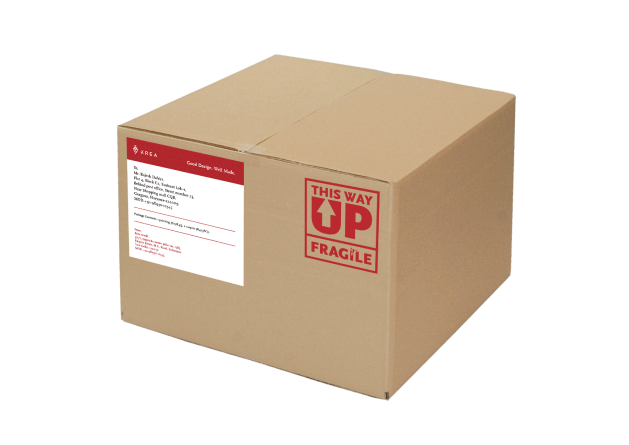
Get the latest from
Eshopbox

A shipping label may appear to be a small and insignificant part of the overall ecommerce puzzle. However, it is crucial to both inward and outward logistics and helps you optimise the order fulfilment process.
It is an identification label which contains vital information about the package and its contents. Shipping labels differ based on the carrier you use, but, more or less, they have the same information like- addresses, names, weight, and a tracking barcode. Without clear and concise shipping labels, orders could be misplaced or mishandled—making the fulfilment process prone to errors. Failing to fulfil orders accurately consistently can curate unpleasant customer experiences, eventually leading to permanent damage to your brand image.
How do shipping labels work?
Shipping labels relay information to direct packages to the correct destination, enable tracking through each stage of the fulfilment process, and ensure implementation of special instructions like 'fragile' or 'priority shipping'.

Shipping labels have unique designs as they have to be read and understood by both humans and machines. Carriers or shipping service providers have designed shipping labels optimised for their process of sorting and delivery—each having a different template.
Structure and anatomy of a shipping label

1: Sender's name and address
2: Recipient's name and address
3: Barcode which can be read in any direction
4: Order ID – a unique number generated when an order is placed
5: The postal barcode
6: Tracking ID – the number given to the customer to track their package
7: Level of Service (e.g. Express, Standard, etc.)
Most of the information is automatically generated by the carrier. The main information you will need is:
- The sender’s name and address
- The recipient’s name and address
- The service method
Note: The standard size of shipping labels is 4 x 6 inches (10 x 15cm). If this doesn’t fit your package, then other standards are 6 x 3 inches (15 x 7cm) and 4 x 4 inches (10 x 10cm).
How to create a shipping label?
Shipping labels are generally generated during the order processing and have precise requirements. You cannot create a new template or fill out a shipping label manually, by hand.
There are two ways to create a shipping label:
Approach 1: Generate a shipping label through a shipping provider for a single order
Approach 2: Leverage a fulfilment partner or a shipping aggregator like Clickpost to automate shipping label generation, printing and allocation.
If you are fulfiling orders in-house for your online store, there exists a plethora of websites and applications that can assist you with shipping label generation and management.
However, if you have outsourced your fulfilment to an end-to-end ecommerce solution provider like Eshopbox; your fulfilment partner will bear the responsibility of generating your shipping labels and attaching them along with their respective orders.
How to print shipping labels?
There are two common, universally accepted ways to print shipping labels:
- Standard Inkjet or Laser printer
You should generally avoid using these printers since they require a lot of ink—which is expensive. Additionally, the printed labels also need some adhesive to stick them to the package. However, these printers are fine if you have to print a handful of labels.

- Thermal label printer
These printers are designed to print labels and are the most preferred option worldwide. There is no requirement of ink; all they need is the rolls of label printing paper. The print is embedded using heat; this allows the labels to display accurate information without smudges, while also having a long shelf life. However, thermal printers are expensive equipment and would only make sense if you have to print shipping labels in bulk.

Where to place shipping labels on the package?
Typically, shipping labels are placed on the most extensive section of the package—to ensure they are evident and scannable without errors.
Larger parcels containing electronics often have labels like 'This Way Up', for cases like these, accurate placement of the shipping label becomes all the more critical.

Tips for shipping label placement:
- Make sure the label is firmly stuck to the package, with no portion hanging out
- Make sure there are no bumps in the shipping label which could hamper its readability
- Ensure that the shipping label isn't folded over any edges
- For locations prone to heavy monsoons, cover your shipping labels with a thin plastic lamination
Shipping label FAQ
Can I print shipping labels at home?
Yes, most major shipping carriers have tools which enable you to generate and print your shipping labels. For instance, tools like FedEx Ship Manager Lite allow you to quickly create shipping barcodes after providing relevant details regarding your package, such as- dimensions, weight, origin, destination, and shipping class (regular or expedited).
Can I handwrite a shipping label?
You can handwrite the address of the recipient. However, a shipping barcode still has to be generated by the shipping provider to initiate the delivery.
Can I generate shipping labels for free?
You can generate a shipping label for free. However, you won't be permitted to ship the package until you have paid for postage.
Shipping with a 3PL
Outsourcing fulfilment to a 3PL (Third-party logistics) company can help you optimise the label generation process. You have to pay for the shipping label, and the 3PL will take care of generating it and ensuring it is firmly secured on the correct package.
Some 3PLs, like Eshopbox, have substantially negotiated rates due to high order volumes daily. This means you get the most cost-effective shipping rates, and therefore by extension, you can offer your customers with cheaper rates as well.
Connect with our fulfilment expert today.
Talk to salesRelated Articles
How can shipping analytics help you predict demand and prevent stockouts?
Top 10 WareIQ alternatives redefining fulfillment and shipping for D2C brands in 2025
Fast-moving goods need faster shipping: How FMCG brands can meet consumer expectations













